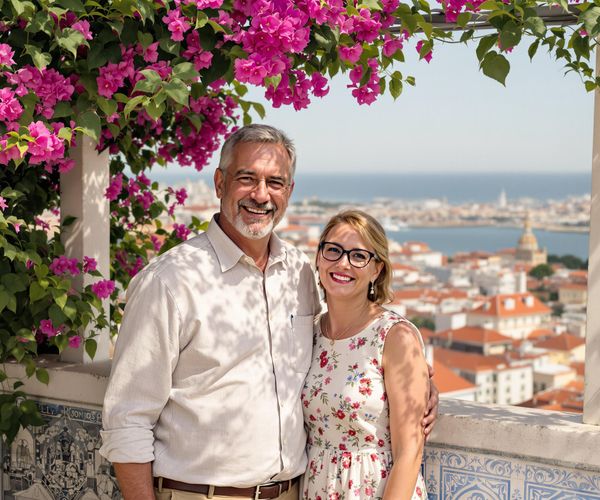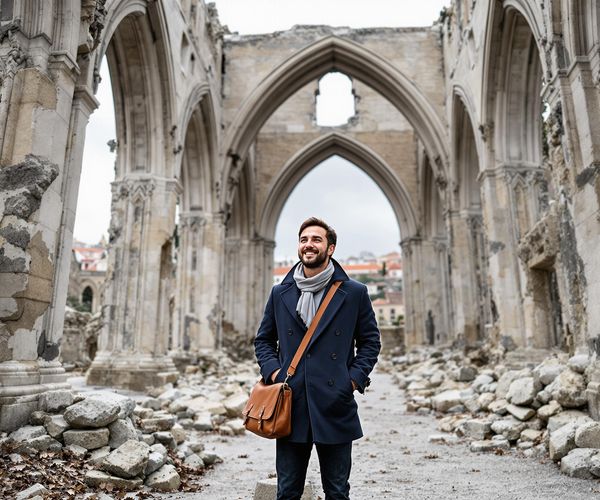Private group Lisbon Roots, Food & Cultural Walk
Highlights
- Discover the real food and culture of Lisbon
- Explore the off beaten path and local neighborhoods
- Taste Portuguese food and its influences
- Enjoy iconic landmarks and breathtaking views of the city
- Immerse yourself in the history and traditions of Lisbon
-
Private Group Experience
-
Duration 3.5 hours
-
Local Guide Included
-
Food & Wine Tastings
-
Snacks and Beverages Included
-
Cultural Insights Provided
Experience the real Lisbon like a local with the Private group Lisbon Roots, Food & Cultural Walk. Escape the tourist traps and immerse yourself in the unique neighborhoods where Lisboners live, eat, drink, and mingle. This private tour takes you off the beaten path to discover the hidden gems of Lisbon's food, culture, architecture, and history. With six stops and more than ten tastings, you'll get a true taste of Portuguese cuisine and its influences. Walk from the historical Lisbon of the 12th century to the vibrant Rossio Square, visit the iconic Elevador de Santa Justa, and explore the multicultural neighborhood of Mouraria, the birthplace of Fado music. This 3.5-hour tour will take you on a journey through Lisbon's past and present, giving you a deeper understanding of this fascinating city.
At a Glance
-
Free cancellation
-
3 hours 30 minutes
-
Instant Confirmation
-
Available in English
-
Mobile voucher
-
Private Tour
-
Guided
-
Adults only
Featured Reviews
Explore Lisbon's hidden gems on a private food and cultural walk, savoring local flavors and immersing in authentic experiences.
Included
-
Alcoholic beverages
-
Local guide
-
Snacks
-
Food tasting
-
Coffee and/or tea
-
Wine tasting
Excluded
-
Gratuities
-
Hotel pickup and drop-off
-
Transportation to/from attractions
Meeting Point
Our host will be welcoming you next Star of David sculpture located in the middle of this little pedestrian square. S/he will be identified with a tote bag with Taste of Lisboa's logo.
Largo São Domingos, 1150-114 Lisboa , Portugal
Pickup
Check if pick-up is available from your location, you will select during checkout (providers may allow other pickup locations)
What to expect
Taste of Lisboa Food Tours
We take you from the historical Lisbon of the 12th century till the current times. In a stroll by the off beaten path starting in Downtown, you will find out why Mouraria is such a unique place - the birthplace of the Fado music and the most multicultural neighborhood in Lisbon. 6 stops and more than 10 tastings are included for you to enjoy and be introduced to very local places where we locals go, and to taste the icons and staples of Portuguese food culture and its influences. - Distance: 1,2 miles/2km. - Duration: 3,5 hours. - Physical level: medium - The itinerary involves a certain amount of uphill walking on cobblestones and climbing down steps, typical of old Lisbon streets.
Igreja De S Domingos
The São Domingos Church, original from the 13th century, has witnessed for centuries faith and massacre, it was several times severely damaged by Lisbon earthquakes and a major fire. After the destructive fire of 1959, it stood closed for several decades. It opened in the 1990s, with a surprisingly simply restored interior, still reminiscent of the signs of the ruins caused by the fire.
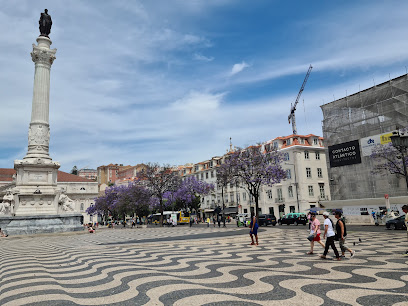
The Rossio is the popular name of the King Pedro IV Square (Portuguese: Praça de D. Pedro IV) in the city of Lisbon, in Portugal. It is located in the Pombaline Downtown of Lisbon and has been one of its main squares since the Middle Ages. It has been the setting of popular revolts and celebrations, bullfights and executions, and is now a preferred meeting place of Lisbon natives and tourists alike. Located in the heart of Lisbon, this vibrant and colorful city square is bursting with flower vendors, shoppers and people bustling to and from their jobs.

One of the city's best-loved landmarks and also known as the "Elevator of Carmo," this extraordinary structure was built in 1902 by the Portugal-born French architect Raoul de Mesnier du Ponsard (an apprentice of Gustave Eiffel, explaining the structure's similarities to Paris' Eiffel Tower), to connect downtown to Bairro Alto (the lowest and highest points of the city). Originally powered by steam, it's 45 meters (147ft) high, and remains an interesting example of post-Eiffel iron architecture. The top of the Neo-Gothic tower, reached via a spiral staircase, has a splendid view of the city, including over Rossio Square, the castle and the river.
Monumento Mouraria Berco do Fado
The expressive monument dedicated to Fado and to Mouraria - Cradle of Fado. It consists of a marble block 1.5 meters high that has carved the Portuguese guitar. It is a tribute to the Fado of Lisboa, which originated in the alleys of this neighborhood, sung by poor people, with suffering lives and generous souls. It is also a tribute to the first great diva of Fado Maria Severa, who lived and died in this neighborhood in the 19th century, and to Fernando Mauricio, the crownless king of Fado during the 20th century and contemporary of Amalia, the great queen of Fado, and to all the most famous or anonymous Fado singers in Lisbon.
Igreja de Sao Cristovao
Probably founded in the 12th century, this church was already used at the beginning of the 14th century. From the intervention of the 16th century, only the rectangular chancel built in 1671 by the Brotherhood of the Blessed Sacrament survived. Rebuilt in the first half of the 18th century, resisted the Lisbon earthquake.

Praça da Figueira is a square in Lisbon Downtown. Prior to the 1755 earthquake, it was the site of the All-Saints Hospital, whose foundations were laid bare during the construction of the current underground car park. In the design of the Marquis of Pombal to Downtown, the square became the main food market of the city. In 1885 a covered market was built there, demolished in the 1950s. Today, the four-story buildings are occupied by hotels, shops and cafes and the square is no longer a market. One of the interesting features is the bronze equestrian statue of D. João I erected in 1971, by Leopoldo de Almeida. The square is served by the Rossio metro station on the Green Line, as well as several public bus and tram lines.
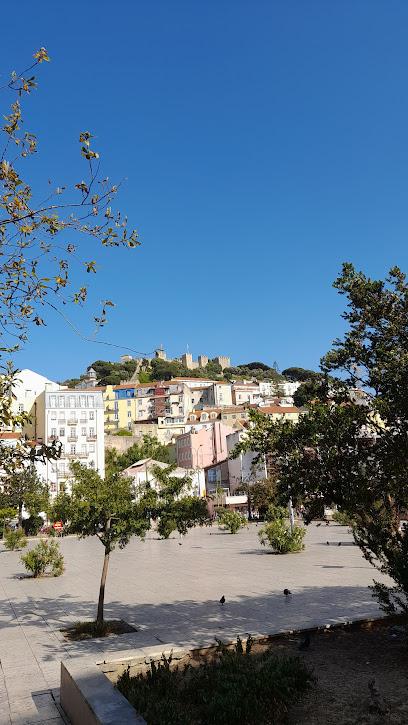
Martim Moniz Square is the starting point of the famous tram 28, a tram line that runs through the oldest part of Lisbon. Although it is a regular transport line, tourists are often the longest in line to board. This square is something of a mini Chinatown, looking up to Saint George castle, and is the gate for Mouraria, the city's most multiethnic and multicultural neighborhood.
Teatro Nacional Dona Maria II
The theater was built in the nineteenth century, comes to us with all the strength of the past when the culture was only accessible to the elites. Today, the theater is open to all. In the main hall, Vihls' giant portraits of great actresses have been printed on the walls, there are guided tours, a bookstore and a friendly lounge with café / restaurant.
Estacao Do Rossio
The Rossio Train Station is the primary train station in Lisbon. This railway station is important for visitors, as it connects Lisbon to the popular town of Sintra and passes the two stations that serve the Palácio Nacional de Queluz. The Rossio Train Station is not only an important station, but also a magnificent building, and a tourist attraction in its own right. The wonderfully ornate exterior of Rossio train station was inspired by classical 16th-century Portuguese Manueline architecture, and passengers enter via two horseshoe-shaped archways, while turrets and pinacols line the roof.
Capela de Nossa Senhora da Saude
The Chapel of Our Lady of Health is located in the Mouraria neighborhood. Built in 1505 by initiative of the artillerymen of the Lisbon garrison, it was dedicated to St. Sebastian, its patron and protector of evils such as war, famine and especially the plague, which had raged in the city and caused hundreds of victims. In 1569, it was dedicated to Our Lady of Health and in 1662 welcomed her image, and became known by that name. It underwent works after being damaged by the earthquake of 1755. However, the portal attributed to João Antunes dates from the beginning of the 18th century. Every year, on the first Sunday of May, the procession of thanksgiving for the protection of the Virgin takes place, a tradition that has been repeated since the 16th century.
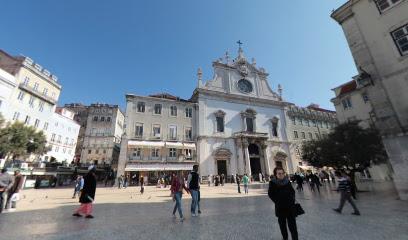
Largo de São Domingos is a square popular among Lisbon’s natives and african community that daily gathers here. A monument mural, inaugurated in 2008, reads “Lisbon, City of Tolerance” in 34 languages recalling the terrible episode of 1506 and paying tribute to the Jewish victims. The square has several stores and cafés, and is home of the famous cherry brandy shop A Ginjinha.
Memorial as Vitimas do Massacre Judaico de 1506
The Lisbon Massacre, also known as 1506 Easter Slaughter, began on a Sunday Mass in April when believers were praying for the end of the drought, hunger and plague that ravaged Portugal at the time. One believer claimed to have had a vision of Christ, a miracle as interpreted by other Catholics. When a New Christian tried to explain the “miracle” as light reflection, the crowd wouldn’t want to listen. The New Christian was beaten to death. Thereafter, all Jews in the city were accused of heresy. It was also here that, some years later, those condemned by the Portuguese Inquisition were left waiting to be burned alive at Rossio. A monument mural, inaugurated in 2008, reads “Lisbon, City of Tolerance” in 34 languages recalling the terrible episode of 1506 and paying tribute to the Jewish victims.
The experience can be subject to change due to bad weather or unforseen circumstances. We always endeavour to give you the best possible experience.
Additional Information
-
Does anyone in your party have any dietary restrictions? (Please be aware we won't be able to adapt the tastings on the day in case you don't inform us in the booking form)
-
Infants are required to sit on an adult’s lap
-
Public transportation options are available nearby
-
Travelers should have at least a moderate level of physical fitness
What our experts say
-
Try the local pastries at A Ginjinha.
-
Visit the Elevador de Santa Justa for views.
-
Wear comfortable shoes for cobblestone streets.
-
Check out nearby Mouraria for Fado music.
-
Public transport is easily accessible nearby.
More About this Experience
Introduction
Escape the touristy traps and crowded streets of Lisbon and embark on a one-of-a-kind adventure with the Private Group Lisbon Roots, Food & Cultural Walk. This immersive tour takes you through the unique neighborhoods where Lisboners live, eat, drink, and mingle, giving you an authentic taste of the city's food, culture, architecture, and history. Led by experienced guides, this off the beaten path experience will introduce you to the hidden gems and local spots that most tourists miss.What to expect?
During this 210-minute tour, you can expect a journey through the history and traditions of Lisbon. Starting in Downtown, you will explore the birthplace of Fado music and the multicultural neighborhood of Mouraria. Along the way, indulge in more than 10 tastings of iconic Portuguese dishes and discover the influences that have shaped the city's food culture. Prepare yourself for a medium level of physical activity as you navigate through cobblestone streets and uphill climbs, all adding to the charm of old Lisbon.Who is this for?
The Private Group Lisbon Roots, Food & Cultural Walk is perfect for all types of travelers who want to delve deep into local culture and experience the true essence of Lisbon. Whether you are a food lover, history enthusiast, or simply curious about the city's hidden gems, this tour will cater to your interests. From solo travelers seeking a unique adventure to couples looking for a romantic experience, and even families wanting to create lasting memories, this tour offers something for everyone. Embrace the inclusivity and diversity of Lisbon as you explore its neighborhoods and meet locals along the way.Why book this?
Booking the Private Group Lisbon Roots, Food & Cultural Walk ensures an unforgettable experience that goes beyond the typical tourist attractions. You'll have the opportunity to immerse yourself in Lisbon's authentic food scene, from traditional dishes to pioneering gastronomic trends. Engage with the city's rich history and culture as you visit landmarks like the São Domingos Church and Rossio Square. With passionate and knowledgeable guides leading the way, you'll gain insights and local perspectives that guidebooks can't provide. This tour allows you to support local businesses and communities, fostering a deeper connection with the city and its people.Good to know
It's important to note that this tour involves a medium level of physical activity, with uphill walking on cobblestones and steps that are characteristic of old Lisbon. So, wear comfortable walking shoes and come prepared for an adventure. The duration of the tour is approximately 210 minutes, during which you'll cover a distance of 1.2 miles (2km). The meeting point is next to the Star of David sculpture, where you'll be greeted by your guide. It's also worth mentioning that the tour includes more than 10 tastings, ensuring you won't leave hungry. Get ready to savor the flavors of Lisbon and discover its hidden culinary treasures.Reviews
Previous participants of the Private Group Lisbon Roots, Food & Cultural Walk have raved about their experiences. Travelers have praised the knowledgeable guides who provide fascinating insights and create a fun and engaging atmosphere. Many have commented on the delicious tastings, saying they were a highlight of the tour. Participants have also appreciated the off the beaten path nature of the tour, as it allowed them to see a side of Lisbon that most tourists miss. Overall, reviews of this tour consistently highlight the unique and immersive experience it offers, making it a must-do for any visitor to Lisbon.Journals from our explorers at this location
This is a popular product and the date you are looking for just sold out. Next available date is













